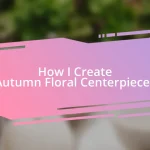Key takeaways:
- Foliage enhances floral arrangements by providing texture, contrast, and depth; understanding its variety and seasonality is crucial for effective design.
- Selecting blooms involves considering seasonal availability, color harmony, texture variety, fragrance, and longevity to create meaningful compositions.
- Maintaining floral arrangements requires attention to water quality, regular upkeep, and cleaning vases to ensure vibrance and longevity of the displays.

Understanding the Basics of Foliage
Foliage is the backbone of any garden or floral arrangement; it provides texture, contrast, and depth. I remember the first time I paired vibrant flowers with lush green leaves while preparing for a friend’s wedding. The realization that foliage could enhance the blooms was revolutionary for me—how could something so simple create such a vivid difference?
The variety of foliage available is astounding, from broad leaves to delicate ferns. I often find myself pondering which types highlight blooms best. Sometimes, I prefer the boldness of larger leaves, while other times, I enjoy the whimsy of intricate fronds. Each choice influences not just the aesthetics but also the mood of the arrangement.
When I consider foliage, I also think about the seasonality of different plants. Each season brings unique options, and I love how the colors and textures shift from spring’s fresh greens to autumn’s warm, rusty hues. Reflecting on this diversity reminds me that understanding foliage is not just about aesthetics; it’s about embracing the beauty of nature’s cycles.

Selecting the Right Blooms
Selecting the right blooms can really elevate your floral arrangements. I remember being captivated by a stunning peony bouquet at a local farmer’s market; the lush, soft petals just beckoned to me. Choosing blooms isn’t just about color; it’s about understanding what you want each flower to convey. Color psychology plays a significant role; for example, reds evoke passion, while yellows inspire happiness. As I pick flowers, I consider not only their hue but also their meaning.
When selecting blooms, keep these key points in mind:
– Seasonal Availability: Opt for flowers that are in season to ensure freshness and vibrancy.
– Color Harmony: Think about how the colors will complement your foliage.
– Texture Variety: Mix different petal textures; I love the contrast of smooth tulips alongside velvety roses.
– Fragrance: Don’t underestimate scent; a delightful aroma can transform the entire atmosphere of your space.
– Bloom Longevity: Choose flowers that will last, especially for special occasions; I’ve learned the hard way to avoid those beautiful but short-lived varieties!
Each time I thoughtfully select blooms, it feels like crafting a story—one that speaks through colors, shapes, and scents.

Complementary Color Schemes in Design
Complementary colors in design play a pivotal role in creating visual harmony. I’ve often found that pairing colors opposite each other on the color wheel amplifies both shades, making arrangements feel vibrant and alive. For instance, when I combined bright orange marigolds with deep blue foliage, it was as if the colors danced together, each enhancing the other’s beauty.
I still remember working on a project where I decided to use a complementary scheme of yellow and purple. Initially hesitant, I chose yellow sunflowers and purple asters, and to my surprise, the result was stunning. The energy of the yellow blooms popped against the rich purple, creating a striking focal point that drew everyone’s attention. It’s this kind of synergy that keeps me exploring and experimenting.
When looking for inspiration, consider nature’s palette. The world around us is full of examples of complementary colors—think of vibrant sunsets where oranges, pinks, and purples converge beautifully. This is where I often find my design ideas flourishing, reminding me that complementary color schemes are not just a technique, but a reflection of nature’s incredible artistry.
| Color Pair | Emotional Effect |
|---|---|
| Blue & Orange | Energetic and Invigorating |
| Red & Green | Bold and Festive |
| Purple & Yellow | Cheerful and Uplifting |
| Pink & Aqua | Fresh and Playful |

Balancing Texture and Form
When it comes to balancing texture and form, I often find it an exhilarating challenge. I remember one particular bouquet where I paired the rigid structure of snapdragons with the feathery softness of astilbes. The contrast not only drew the eye but also created a sense of movement and depth that elicited an emotional response from anyone who saw it. Isn’t it fascinating how a simple mix of textures can transform the overall impact of an arrangement?
Texture brings an undeniable richness to floral designs. Think about it: combining bold, spiky succulents with delicate, cascading vines offers a visual narrative that conveys a garden’s untamed beauty. In one of my favorite arrangements, I included a rough, textured artichoke amid lush, frilly ferns. The juxtaposition led viewers to explore the arrangement further—their eyes danced across each element, drawn in by the myriad forms.
As I experiment with different textures, I’m continually inspired by nature’s contrast. I vividly recall a walk through a botanical garden, where I was struck by how the coarse bark of a tree harmonized with the silky petals of nearby blooms. That moment highlighted for me the importance of not just choosing flowers that look good together, but also those that play off each other’s textures and forms to create a dynamic whole. How do you create that balance in your own arrangements? It’s definitely a journey worth embarking on!

Seasonal Considerations for Arrangement
In considering seasonal arrangements, I’ve learned that the time of year significantly influences the types of foliage and blooms available. For example, during autumn, I find myself drawn to the warm tones of dahlias and the vibrant reds of Japanese maple leaves. This combination not only captures the essence of the season but also evokes a cozy feeling that makes each arrangement feel like a warm hug.
Winter brings its own set of challenges with limited flower options. I often turn to hardy evergreens and the striking contrast of winter-blooming hellebores. I remember creating a winter centerpiece with fresh pine boughs accented by the deep plum of hellebores; the result felt both festive and serene, perfectly embodying the tranquility of a snowy landscape. Have you ever paused to appreciate how the starkness of winter foliage can create just as much beauty as vibrant spring blooms?
As we transition into spring, the palette transforms and bursts into life. I love mixing the soft pastels of tulips with the rich greens of newly sprouted leaves. It’s as if the flowers are celebrating the return of warmth and growth. One spring, I arranged a bouquet that featured bright pink peonies alongside delicate ferns, and the energy felt refreshing and hopeful. How do you reflect the changing seasons in your designs? Finding ways to incorporate seasonal elements can truly elevate your arrangements.

Tips for Long Lasting Compositions
To ensure your floral compositions stand the test of time, water quality can make all the difference. I always emphasize the importance of using clean, fresh water with a floral preservative. Once, I neglected this detail in a stunning arrangement of roses and eucalyptus, and it was disheartening to watch it wilt sooner than expected. Have you ever experienced that? The right water can be a game changer, helping to maintain vibrant colors and sturdy stems.
Another tip I swear by is selecting blooms that naturally last longer, such as chrysanthemums or lilies. I once crafted a stunning display for a friend’s wedding using these resilient flowers, and the arrangement was not only beautiful but remained lush throughout the event. It made me realize how thoughtful flower selection combined with longevity considerations can both enhance the visual appeal and create lasting memories.
Lastly, attention to environmental conditions plays a pivotal role. I still remember arranging flowers for an outdoor summer event; despite my preparation, the heat took a toll, causing some delicate flowers to droop. Now, I always suggest placing arrangements in cooler areas whenever possible. By being mindful of temperature and humidity, you can extend the life of your floral compositions while ensuring they look their very best. Have you given this aspect much thought? It’s a simple yet impactful strategy that can greatly enhance your floral success.

Maintenance for Vibrant Displays
Maintaining vibrant displays is all about the little details that can make a big impact. I can’t stress enough how often I check my arrangements for wilting leaves or faded petals. Just the other day, I spotted some drooping greens in a bouquet I had left on my kitchen counter. It was a reminder that regular upkeep isn’t just a chore; it’s part of the joy in nurturing the life of my blooms. So, have you checked your arrangements lately?
One of my favorite practices is to refresh the water every few days. I remember a stunning arrangement of mixed wildflowers I crafted for a friend’s birthday. Initially, it was bursting with color, but within a week, it began to lose its magic. A quick water change not only revived the composition but also reinvigorated my friend’s excitement as the bouquet blossomed all over again. Have you ever thought about how a simple act could bring your arrangements back to life?
Cleaning the vase is another crucial step often overlooked. I once used a beautiful antique vase for a special dinner party without washing it thoroughly, thinking it just needed a rinse. To my horror, the flowers struggled to thrive, and the water turned murky far too quickly. This experience taught me that even the most cherished containers need proper care to showcase their contents beautifully. How do you treat your vases? A little attention to detail can keep your displays radiant and full of life.














